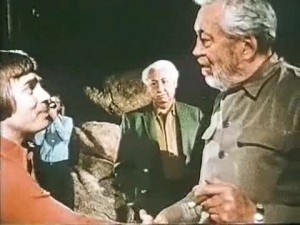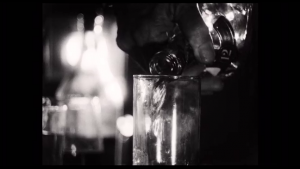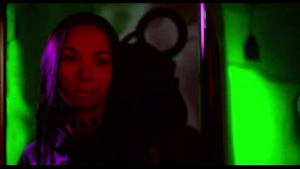Written for my collection Cinematic Encounters 2: Portraits and Polemics (2019), although it has also appeared by now in Spanish (in Caiman Cuadernos de Cine, November 2018), in Persian (in Sazandegi, December 19-20, 2018), and in French (in Trafic, March 2019). The Other Side of the Wind is still visible and available on Netflix, but I think we’re still a long way from it being adequately “digested” or coherently dismissed, much less adequately defined. (I’ve also heard from Criterion, which has an arrangement with Netflix, that they have no plans to release the film digitally.) Even those who consider it a failure haven’t, for the most part, come up with very persuasive accounts of what it is and does. Superficial replays of rumors about the film that circulated decades ago, many of them half-baked, continue to predominate. But of course this is nothing new when it comes to groping after the meaning and value of Welles’ work, which rarely comes at the time a film is released,. — J.R.
The Other Side of the Argument:
First Thoughts on Orson Welles’s Demonic Fugue
The only time I ever met Orson Welles — in 1972, in response to a letter of mine, to discuss his very first Hollywood project, an updated adaptation of Conrad’s Heart of Darkness that I was writing about — I also had occasion to ask him about the status of his more recent projects. There was the film called Hoax that he was currently editing, which later became F for Fake (“not a documentary,” he assured me, but “a new kind of film”); two films that he declared were nearly done but he was in no hurry to release, The Deep and Don Quixote; and a still-unfinished film, The Other Side of the Wind, that he wanted to release ahead of the others because it was about movies and “movies are a popular subject now,” though he wasn’t sure how long this interest would last.
Forty-six years later, a posthumously completed version of the latter, put together by several hands — including Peter Bogdanovich, who also costars as a character much like himself, production manager Frank Marshall, and two later arrivals, editor Bob Murawski and producer Filip Jan Rymsza — is opening in the United States, and as luck would have it, it may be even timelier now than it might have been in the seventies. This isn’t because of its ostensible mythic subject, The Death of Hollywood, but because of its other mythic concern, The Death of Macho, which the film proposes as intimately (if covertly) connected with its “popular subject” — indeed, as something akin to a subject that dare not speak its name. All of the film’s action unfolds on July 2, pointedly the date of Ernest Hemingway’s suicide, and if death of one kind or another remains one of the most common preoccupations of Welles’s fourteen released features, the alleged death of Hollywood — combined with the deceptive teaser of a tell-all autobiography about an aging maverick director trying to finance the completion of his final independent feature — is the part of the film’s subject designed to get an audience inside the tent. Yet it’s the other subject and the other Death that will undoubtedly spark the most debate and controversy. The first Death, mainly fun and games spiced with witty gossip and the cult of celebrity (featuring such familiar names as Mercedes McCambridge, Cameron Mitchell, Edmond O’Brien, Paul Stewart, and, in bits, everyone from Claude Chabrol, Dennis Hopper, and Curtis Harrington to Henry Jaglom, George Jessel, and Paul Mazursky) — even though it’s edited with the rapid, kamikaze shot collisions Welles developed in such globetrotting ventures as Othello, Mr. Arkadin, The Trial, and F for Fake, pushed here to even more aggressively discontinuous and discombobulated extremes — is clearly the one most cinephiles have been awaiting and expecting, and the one more appealing to mainstream taste. But the second one, pitched in the form of an arty countercultural nightmare about gender reversals (some of which parallel those in Hemingway’s posthumously assembled The Garden of Eden), sexual humiliation, coitus interruptus, impotence, and castration, without any stars or dialogue, is the one that stings and lingers. The resulting toxic brew may constitute Welles’s only feminist film, if only by default, yet the brand of feminism it suggests — predicated in part on the fierce silence of a nameless Native American actress both at the party and in a macho director’s unfinished film, glowering in mute and furious judgment at his behavior and world — has too many sinister aspects to be regarded as either affirmative or politically correct. Like the Victorian notions of dirty sex that course through Welles’s debatable version of The Trial, ravenous nymphets and all, it seethes with demonic unhealthiness.
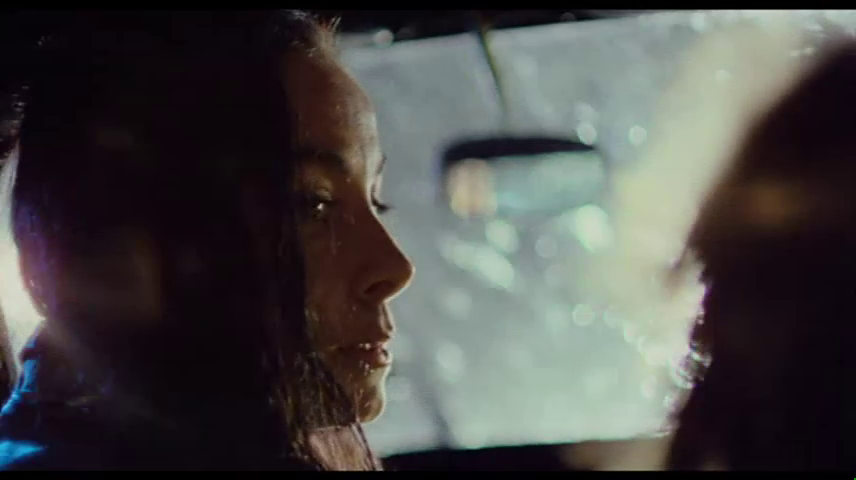
Why it took almost half a century for The Other Side of the Wind to be completed has already been the focus of one book by Josh Karp1 as well as a documentary feature, Morgan Neville’s They’ll Love Me When I’m Dead, that in some ways confuses as much as it clarifies (by wrongly suggesting, for instance, that the film’s scenes were mostly improvised rather than scripted, and by being edited in a breezy manner that misrepresents the controlled cacophony of Welles’ own style). It’s a complicated, dispiriting tale of bad business deals, chicanery, lawsuits, and, finally, impounded footage in Paris that prevented Welles from editing more than about a third of the two hours of projected running time. When I first met Oja Kodar — who is the film’s lead actress (as the silent Native American) and coauthor — a few months after his death in 1985, which eventually led to both our friendship and her asking me to edit Welles’s interview book with Peter Bogdanovich,2 she told me that the film’s correspondence file was as hefty as War and Peace. Visiting her at the Villa Welles in Primošten, Croatia early last July, I saw substantial proof of this claim when she finally stacked the file on her kitchen table for me to examine. But apart from assertions by Welles in that pile that confirmed all her shy and mainly reluctant admissions of her creative contributions to the film, which I have been gradually trying to coax out of her for more than three decades, this isn’t a tale that I have any appetite for recounting here. What the film says and does is far more interesting.
The Death-of-Hollywood scenario centers on the seventieth birthday party of Jake Hannaford (John Huston), held at the ranch of his old actress chum, Zarah Valeska (Lilli Palmer — a part reportedly offered first to Marlene Dietrich), rendered via super-8 and 16mm footage and still photographs, in both color and black and white, and audiotapes, all allegedly recorded by various attendees in a pseudo-documentary style that remained part of Welles’s standard arsenal (as in his Shakespearean Caesar on stage, The Twelfth Night on 78 rpm, The War of the Worlds on radio, and, in film, the Citizen Kane newsreel, the openings of The Magnificent Ambersons and Mr. Arkadin, and F for Fake). Intercut with this material is Hannaford’s unfinished film The Other Side of the Wind, in color, screened first for a studio honcho (who disdainfully walks out), then at the party, and finally in a nearby drive-in theater after two power outages at the ranch, both of which further evoke impotence and/or interrupted sex. In contrast to the party, full of lively chatter (though almost completely and mysteriously devoid of any couples), this film has no dialogue and basically consists of the flirtations, foreplay, struggles, and sexual encounters between a passive, effeminate, nameless hunk first seen on a motorcycle (Bob Random playing the actor John Dale, mostly and appropriately like a “found” object or one of the many prop dummies brought to the party) and an equally nameless Native American radical and dominatrix (Oja Kodar), both of them naked for much of the time — getting it on first in the front seat of a car during a rainstorm (until the driver throws both of them out), then on the bare springs of a mattress-less bed in the open air on a studio backlot.
At the party we learn that the film is unfinished because Dale quit in the midst of shooting. Eventually, in the film being screened, and specifically during the latter sex scene, we discover why: being sexually taunted and humiliated by Hannaford from behind the camera and threatened with a pair of scissors by his costar (until she cuts her bead necklace instead, and her beads spill and scatter like semen), he stomps off the set, with Hannaford instructing his cameraman to film his departure. At the drive-in, we also hear the charge from a journalist (Susan Strasberg playing a cross between Pauline Kael and Barbara Leaming) that super-macho Hannaford has a homoerotic bent — a charge that eventually goads Hannaford into slapping her. (Characteristically, this slap seems calculated to solicit our righteous applause — and not because she’s wrong but because she’s right.)
Ever since enjoying a mainstream profile in his youth, Welles was reluctant to see himself as an arthouse filmmaker, although this was the status he mainly wound up with. It was only after Pauline Kael described Citizen Kane as a Hollywood newspaper comedy that his aberrant first feature got ushered belatedly into the mainstream, and the reason Welles gave me in 1972 for holding back his low-budget Don Quixote was that he didn’t want it to compete with Man of la Mancha. So it’s unsurprising that he described Wind as a movie about movies, his mainstream subject, rather than as an experimental art film about fading sexual confidence and diminished career options.
The fact that it’s both becomes an essential part of its fascination: a duet or duel between conflicting self-images. The contrasts between the film’s two alternating blocks of material are indeed so striking that they need to be regarded in musical terms, as the separate melodic lines in a fugue: reams of dialogue versus no dialogue at all, old age versus youth, color plus black and white in diverse formats versus just color 35-millimeter, and, perhaps most crucial, lone figures at a noisy party versus a movie couple coupling. Even though the sexual encounters of the latter between a dominatrix and her prey end in coitus interruptus, the two are always continually engaged with one another, even in their perpetual conflict, whereas the party guests and hostess are perceived mainly as disengaged and lost, solitary souls seeking some form of social communion. And the musical coupling of these two strands is visceral as well as conceptual: visual and aural close-ups of Hannaford pouring liquor into a shot glass make voluptuous audiovisual rhymes with the rain splashing against car windows in accompaniment to the movie sex.
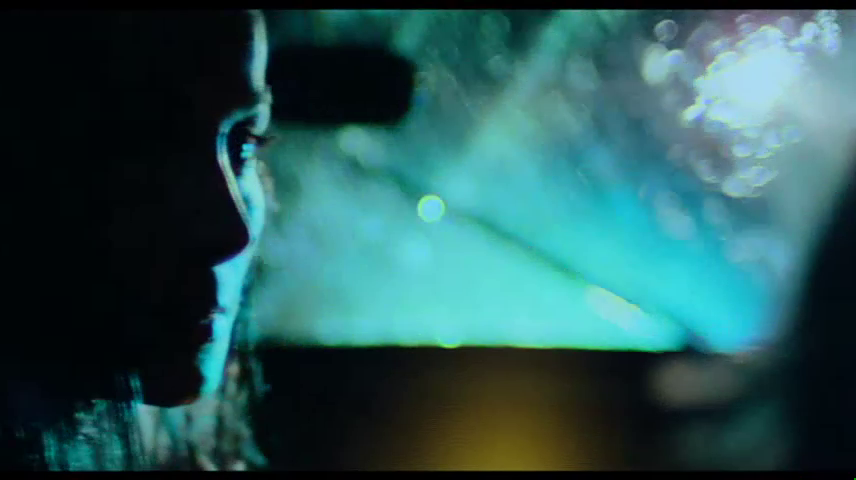
Welles’s part of the script relates to Hannaford as played by Huston; Kodar’s part relates to Hannaford’s film in which she implicitly plays Hannaford’s sexual surrogate — a predator who, as Kodar has described her conception of the part, resembles a praying mantis. Although this film-within-the-film has often been described as Welles’s parody of Zabriskie Point — based on his outspoken disdain for Michelangelo Antonioni as an “architect of empty boxes” — Kodar’s own acquaintance with Antonioni’s work remains minimal, and the artiness and Freudian symbolism of Hannaford’s film is chiefly her contribution, even though the anxiety about countercultural androgyny and passivity as a threat to aging macho values clearly belongs to Welles. Kodar directed three sequences — in the car, inside a disco’s ladies room, and on a surrealist beach in the final scene, where a giant phallus actually topples in defeat — and a temporary illness prevented Welles from being present at the shooting of the second of these scenes, perhaps the creepiest in the film. More generally, Kodar’s background as a sculptor — she was the first woman ever admitted to the sculpture department of Zagreb’s Academy of Visual Arts — informs the diverse settings of Hannaford’s film, whether they’re created or found (as in the MGM backlot, where she and her costar managed to sneak in with Welles and a skeletal crew for about a day and a half of continuous shooting). Most of her sculptures are both abstract and erotic, and the same might be said of the disco nightclub where she cuts the eyes off a doll given to her by her sparring partner — the film’s first symbolic castration — in order to wear them defiantly as earrings. (If the disco recalls the funhouse in The Lady from Shanghai — and its ladies room evokes the giggling girls peeking through slats into an artist’s garret in The Trial — this only further suggests that Kodar’s multiple collaborations with Welles, however dialectical, could also sometimes attain a genuine osmosis.)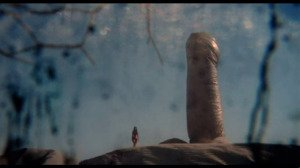
What inspired her to play a Native American radical was an incident during her first visit to Hollywood. As she recounted to me in a public interview held in 2015 in Woodstock, Illinois (the site of Welles’s prep school), Welles acquired a car and a driver named Hymie to take her on a solitary tour. On Hollywood Boulevard, “a short, stocky, dark-complexioned man was jaywalking,” and an enraged Hymie stopped the car, rolled down a window, and barked out at him, “Move your ass, you red son-of-a-bitch.” She got out of the car, not wanting to be driven any further by Hymie, and before she walked back to Beverly Hills, tried to follow the stocky man from a discreet distance, until he gave her a look “and I felt as though I was trespassing.”
Kodar knows better than anyone that the public wants a movie by Welles, not a film coauthored by herself, and being mainly a willing outsider to the film world apart from her involvement with Welles, she shares with him the paradoxical temperament of being a reclusive exhibitionist — that is to say, an exhibitionistic artist who treasures her solitude and remoteness. (This remoteness — coupled with living in a Croatian village not far from her birthplace that has limited internet access — has made her an easy scapegoat for some Welles enthusiasts and commentators, mostly male, who feel obliged to fill in various journalistic blanks, so that Josh Karp’s assertion that she “allegedly collaborated on the screenplay” of Wind4 is characteristic.) But Welles choosing to complicate his own exhibitionism in The Other Side of the Wind by factoring hers into its textures and delivery is a process that he would carry out again, albeit more modestly, in F for Fake (as well as in many of the unrealized projects that they collaborated on). Both films combine stories by each of them that involve her brazenly parading her beauty and body (before a fictionalized Pablo Picasso in F for Fake) while he no less brazenly parades his verbal wit and eloquence (with John Huston as his fictionalized mouthpiece in Wind) — even though she was the one who came up with the titles for both films. As James Naremore has recently pointed out,3 Wind grew out of a story by Welles called The Sacred Beasts about a burned-out Hemingway-like aficionado with homoerotic leanings — a tale likely inspired by Welles’s first encounter with Hemingway, while recording a voiceover for Joris Ivens’s This Spanish Earth and being accused by Papa of sounding like a queer — which, according to Welles, led first to fisticuffs and then to an edgy friendship (the sort of ritual commonly enacted by Howard Hawks’s heroes). To this story was added Kodar’s own tale about an unconsciously homosexual director who sleeps with his leading ladies after they sleep with his leading men, thereby “possessing” his male discoveries at one remove, and is brutally homophobic in the bargain.
How autobiographical The Other Side of the Wind actually is will no doubt keep some Welles buffs preoccupied for years to come. Even though Hannaford is plainly modeled on such macho directors as Ford, Hawks, Walsh, and Huston himself, he’s also furnished with such acolytes as Bogdanovich and Joseph McBride (in a smaller role), both known for their associations with Welles and encouraged to parody themselves. Meanwhile, John Dale is assigned a tweedy prep-school mentor named Burroughs (Dan Tobin) who evokes Welles’s own beloved Roger Hill in Woodstock, and is shamelessly gay-baited by Hannaford — in one of the film’s most nerve-wracking encounters, edited according to their respective stares in a manner calculated to make an audience squirm. (The confrontational power of Welles’ editing has, alas, been reduced by the strains of an offscreen piano.)
Yet I find all the elements of an autobiographical fan-dance far less intriguing than the overriding ambiguities of Welles’s art regarding the unresolvable mysteries of human personality. He planned to play a gay Kissinger-like figure in The Big Brass Ring, but arguably far more relevant is the reporter’s assertion in Citizen Kane that “I don’t think any word can explain a man’s life,” in contradistinction to “Rosebud” (the mainstream payoff), or the seeming discrepancies between the present and evoked past personae of the title figure of Mr. Arkadin or Hank Quinlan in Touch of Evil. In keeping with such conundrums, and for better and for worse, Wind finally offers us two disparate Jake Hannafords — the charismatic rascal maverick concocted by Welles and Huston and the elusive fag artist in denial devised by Welles and Kodar — who don’t really match up. There’s a flagrant lack of congruence between the former, American to the core, and the Eurotrashy tang of the latter. The real Hannaford (if there is one), a perpetual enigma, must lie somewhere in between these versions, but precisely where and how he lies (in both senses of the word) is entirely up to us. Indeed, he’s so strategically opaque that when he delivers a “witty” racist speech to Kodar’s character at his birthday party — even calling her Pocahontas in what must be the timeliest of historical coincidences — he does so in the manner we recognize from Donald Trump’s mockery of Elizabeth Warren whereby racism and a conscious parody of racism become indistinguishable and interchangeable.
When I met Welles in 1972, I was disappointed to discover that the man I thought would be the ideal film adapter of Light in August (while playing the role of Reverend Hightower) actually preferred John O’Hara, F. Scott Fitzgerald, and Hemingway to William Faulkner. But he also admitted to me that he used to hang out in Hollywood with Nathanael West, and it’s surely West’s view of Hollywood that informs The Other Side of the Wind rather than O’Hara’s or Fitzgerald’s. One of Hannaford’s many stooges and apologists, Billy Boyle, beautifully played by Welles’s former director-colleague Norman Foster — a jittery former alcoholic who stays on the wagon by gobbling gumdrops, until the tensions and remonstrations of the evening finally send him back to the bottle (and hardly anyone in his crowd seems to notice, or care) — is a classic loser out of The Day of the Locust, a blood brother of Homer Simpson, swimming through the same universe of casual cruelty and thwarted hopes. And the alternate universe provided by Hannaford’s stab at a trendy youth movie, even with its glitzy evocations of sex and violence, proves to be even harsher — a blighted view of hippie utopia that could have been hatched in the brain of Miss Lonelyhearts’ Shrike.
In the interest of full (if belated) transparency, I was one of the two consultants who worked on the completion of Wind (Joseph McBride was the other). Even though I have a few, mostly minor differences with Bogdanovich, Marshall, Murawski, and Ryszma, who did most of the work (and with Michel Legrand, who provided the score—lamentably without Welles’ supervision, which yielded his excellent contributions to F for Fake) — all of whom, along with McBride, are more oriented toward mainstream editing conventions than I am — these differences are secondary to my gratitude that they’ve finally managed to make available a very radical and challenging work that otherwise would have been lost to history, film history included. So rather than deal with those differences here, I’d like to emphasize that in keeping with Welles’s career-long aptitude for defying and confounding most of our expectations about his work, Wind can’t truthfully be regarded as his “last feature,” at least without a great deal of boiling and scraping that entails further obfuscation. Most of it was conceived and shot before F for Fake and Filming “Othello” (the latter finally made available on Criterion’s recent and superb digital release of Othello, which also makes Welles’s own two versions of Othello fully available for the first time on DVD and Blu-Ray), so trying to assign it the status of Welles’s “final” work or statement essentially means trying to give it a commercial form of closure rather than a plausible or meaningful critical definition that can only reduce its challenges and provocations. To keep it alive and worrying, as a film addressed to the present moment, I think we need to suspend some of our verdicts until we all become better acquainted with it as a foreign and somewhat scary object. It may even have more to say to us than Welles was aware of. Among other Wellesian specialists, I can think of at least four — three in Europe, a fourth in the United States–who firmly believe that a “completion” of this unfinished work shouldn’t have been undertaken in the first place, and even though I disagree with them, I would concede that at least two of them have cogent arguments to support their positions. But now that a film called The Other Side of the Wind finally exists as a fait accompli, I would maintain that the primary task we’re now faced with isn’t so much to determine whether or not it has a right to exist as to question what it is and does. After waiting for it for nearly half a century, a rush to judgment isn’t exactly called for.
Notes
1. Josh Karp, Orson Welles’s Last Movie: The Making of The Other Side of the Wind (New York: St. Martin’s Press, 2015).
2. Orson Welles and Peter Bogdanovich, This is Orson Welles (New York: HarperCollins, 1992; revised 2nd ed., New York: Da Capo Press, 1998).
3. “Orson Welles, Citizen of the World,” written for the Brazilian/French digital project Transatlantic Cultures: A Dictionary of Cultural History, edited by Eduardo Morettin and Caroline Moine. The original English text can be found at jamesnaremore.net.
4. Karp, op. cit., 45.

